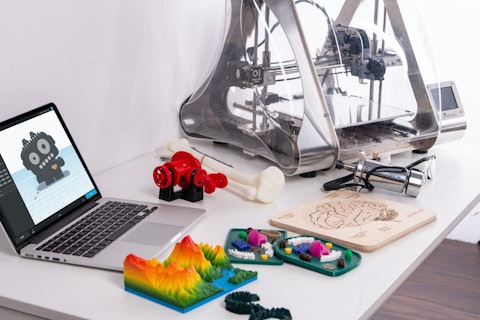In this article, we will be taking a looking at the 15 most advanced countries in 3d-printing technology. You can also skip our detailed analysis on 3D printing market and directly head to the 5 Most Advanced Countries in 3D-Printing Technology.
Explosive Growth of the Global 3D Printing Market: Projections and Key Players Driving Innovation
The global 3D printing market is experiencing significant growth, driven by technological advancements and increasing applications across various industries. The market size was valued at approximately USD 20.68 billion in 2023 and is projected to reach USD 117.78 billion by 2033, expanding at a compound annual growth rate (CAGR) of 19% from 2024 to 2033.
To build their position in this field, numerous tech businesses have also begun releasing products in the 3D printing and additive manufacturing market. In addition to creating and releasing its 3D printers, Microsoft also developed and released the 3D Builder application. One of Autodesk’s most well-known products is Autodesk Fusion, an essential tool for setting up 3D models for printing. Ultimately, HP is famous for its Multi Jet Fusion 3D Printing technology in addition to its other offerings in this field.
The 3D printing market in the United States significantly contributes to the global market. In 2023, the US market was valued at USD 4.95 billion and is expected to grow to USD 29.90 billion by 2033, with a CAGR of 19.7% from 2024 to 2033. North America, led by the US, dominated the global market in 2023, generating over 34.14% of total revenues.
Key Players Shaping the 3D Printing Market
Companies like Nano Dimensions Ltd. (NASDAQ:NNDM), Stratasys Ltd. (NASDAQ:SSYS), and 3D Systems Corporation (NYSE:DDD), among others, have been prominent players in the 3D printing market. Nano Dimensions Ltd. (NASDAQ:NNDM) is a leader in additive Manufactured Electronics (AME), offering solutions that transform digital designs into electronic or mechanical devices on demand. Nano Dimensions Ltd. (NASDAQ:NNDM) is acquiring Desktop Metal, a company known for its 3D printing hardware and design software for metal and carbon fiber parts. This acquisition is expected to close in the fourth quarter of 2024 and is anticipated to generate over $30 million in cost savings. The company has implemented cost-saving measures, including a 25% reduction in workforce and operational expenses. These measures are projected to save between $12 million and $20 million annually, contributing to a significant reduction in net cash burn. Nano Dimension reported unaudited consolidated revenues of approximately $14.8 million for the second quarter of 2024. This represents an 11% increase compared to the previous quarter.
Similarly, Stratasys Ltd. (NASDAQ:SSYS). is also a prominent leader in the 3D printing and additive manufacturing industry, known for its extensive range of technologies, materials, and services that cater to various industries such as aerospace, automotive, healthcare, and consumer products. Stratasys has been actively advancing its additive manufacturing strategy by introducing new 3D printers that leverage FDM, P3, and SAF technologies. In collaboration with Siemens Healthineers, Stratasys Ltd. (NASDAQ:SSYS) is working on a landmark research project to develop advanced solutions for medical imaging phantoms, which are crucial for computed tomography (CT) imaging. Stratasys reported a 3.7% decline in 2023 revenues, totaling $628 million. For 2024, Stratasys forecasts revenue between $630 million and $645 million, with the majority of growth expected in the second half of the year. Stratasys anticipates a GAAP net loss of $88 million to $72 million, but a non-GAAP net income of $9 million to $14 million for 2024.
Last but not least, 3D Systems Corporation (NYSE:DDD) has also been actively involved in various sectors, including medical, dental, aerospace, and automotive industries. In recent years, 3D Systems has experienced a resurgence in growth after a brief downturn during the early days of the COVID-19 pandemic. The company has leveraged its extensive experience and global reach to attract new business as the 3D printing industry continues to expand. As far as the financials are concerned,3D Systems Corporation (NYSE:DDD) has not released its 2024 financial statistics yet but the company’s 2023 fourth-quarter revenue was $114.8 million, a decrease of 13.5% compared to the same quarter in 2022. This decline was primarily due to softness in the dental orthodontics market and reduced printer sales resulting from delayed customer capital expenditures. The gross profit margin for Q4 2023 was 40.4%, with a non-GAAP gross profit margin of 41.9%, representing an increase from the previous year due to a favorable product mix. The total revenue for 2023 was $488.1 million, down 9.3% from $538.0 million in 2022.
While we acknowledge the potential of DDD as an investment, our conviction lies in the belief that some AI stocks hold greater promise for delivering higher returns, and doing so within a shorter time frame. If you are looking for an AI stock that is more promising than DDD but that trades at less than 5 times its earnings, check out our report about the cheapest AI stock.

xiaole-tao-Fo-HQUlRGkU-unsplash
Our Methodology
For our methodology, we have ranked the most advanced countries in 3D printing technology based on Insider Monkey Scores. We incorporated several weighted criteria for these scores, including start-up scene in the 3d printing space, and population-adjusted patents and H-index for research papers published related to 3d printing and additive manufacturing.
At Insider Monkey we are obsessed with the stocks that hedge funds pile into. The reason is simple: our research has shown that we can outperform the market by imitating the top stock picks of the best hedge funds. Our quarterly newsletter’s strategy selects 14 small-cap and large-cap stocks every quarter and has returned 275% since May 2014, beating its benchmark by 150 percentage points (see more details here).
Here is our list of the 15 most advanced countries in 3D printing technology.
15. Denmark
Insider Monkey Score: 0.06
Denmark’s robust manufacturing industry, with its focus on precision engineering and high-quality production, has embraced 3D printing technologies to enhance production processes, reduce costs, and improve product customization.
Organizations like the Danish AM Hub and the Manufacturing Academy of Denmark (MADE) actively promote 3D printing through initiatives and demonstration projects. These efforts help manufacturers test and implement new materials and production methods. The Danish additive manufacturing market is experiencing rapid growth, valued at $114.08 million in 2022. It is projected to reach $592.53 million by 2030, with a compound annual growth rate (CAGR) of 22.8% from 2023 to 2030. Major global players like Stratasys, Markforged, Desktop Metal, and General Electric are active in the Danish market.
14. Belgium
Insider Monkey Score: 0.13
Belgium’s success in 3D printing can be largely attributed to the strong collaboration between universities, research institutions, and private companies. In 2017, Flemish universities, social organizations, and companies formed a partnership to promote the use of 3D printing in the construction sector in the Flanders region. The country has made substantial investments in 3D printing infrastructure. For instance, partners invested about €1.6 million in new 3D printing infrastructure at Kamp C, a support center for sustainable building and living in Antwerp. This investment has enabled the creation of advanced facilities for research and development in 3D printing. A 3D-printed model house in Belgium reportedly costs about 60% less than a typical brick home, suggesting potential cost savings in the construction industry.
13. Sweden
Insider Monkey Score: 0.2
Sweden consistently ranks as the EU’s most innovative country, providing a fertile ground for 3D printing advancements. This culture of innovation has led to the rapid adoption and development of additive manufacturing technologies across various industries. Sweden produces more than one-quarter of the global supply of metal powder for additive manufacturing Several Swedish companies are leading 3D printing innovation. GKN Aerospace invested £50 million in advanced 3D printing in Trollhättan. Siemens Industrial Turbomachinery cut material use by 50% in gas turbine production with 3D printing. Arcam is a pioneer in metal 3D printing, while Höganäs, Sandvik, and Uddeholm are key global suppliers of metal powders for 3D printing. Swedish universities are also advancing 3D printing research. At KTH Royal Institute of Technology, researchers have developed methods to 3D print silica glass micro-optics on fiber tips, which could lead to faster internet and more sensitive remote sensors.
12. Spain
Insider Monkey Score: 0.26
Spain hosts world-class research facilities dedicated to 3D printing. The HP 3D Printing and Digital Manufacturing Center of Excellence in Barcelona stands out as one of the largest and most advanced 3D printing research and development centers globally. Spanning over 150,000 square feet, this facility brings together hundreds of experts in additive manufacturing to drive innovation in the field. Spain is home to groundbreaking 3D printing projects. The Institute for Advanced Architecture of Catalonia (IAAC) has constructed a prototype building named TOVA using 3D printing technology and sustainable materials like earth, aloe, and egg whites. This project demonstrates Spain’s commitment to exploring eco-friendly applications of 3D printing in architecture Spanish companies are collaborating with global leaders in various sectors to advance 3D printing applications. For instance, HP’s center in Barcelona partners with firms like BASF, GKN Metallurgy, Siemens, and Volkswagen to develop new 3D printing and digital manufacturing solutions.
11. Switzerland
Insider Monkey Score: 0.33
Switzerland leads Europe in 3D printing patent applications per capita and in economic performance. Between 2001 and 2020, Swiss companies and universities filed approximately 8% of the patent applications related to 3D printing technologies in Europe. Switzerland’s 3D printing advancements are driven by strong research institutions like EPFL, CSEM, and the iPrint Institute. The Micromanufacturing Science & Engineering Center (M2C) in Neuchâtel fosters industry-academia collaboration, covering research to technology transfer. A focus on sustainability includes EPFL’s creation of eco-friendly 3D printing materials. Swiss companies apply 3D printing across sectors such as medical devices, aerospace, watchmaking, and microfluidics. In 2024, Holcim completed Switzerland’s first onsite 3D-printed building, a 150 m² showroom with 6.2-meter-high walls, printed in just 55 hours over 8 days.
10. Japan
Insider Monkey Score: 0.4
Japan’s long-standing reputation for precision manufacturing and quality control has translated well into the 3D printing sector. The country’s expertise in robotics, automation, and advanced materials has provided a solid foundation for AM innovation. In 2024, Kurimoto opened Japan’s largest metal AM facility, equipped with newly installed LPBF machines from GF Machining Solutions, signaling a major investment in industrial-scale 3D printing capabilities. Japanese companies are leveraging 3D printing for aerospace components. For instance, IHI AEROSPACE has partnered with 3DEO to enhance the adoption of AM technologies in the aerospace sector. Apart from that, Japanese researchers have made significant strides in bioprinting. A team from Osaka University has successfully 3D printed Wagyu beef, demonstrating the potential for creating complex biological structures.
9. Italy
Insider Monkey Score: 0.46
Italy stands ninth in our list of the most advanced countries in 3D printing technology. Italy is home to innovative 3D printing companies like WASP, which focuses on large-scale printers using local materials like clay; CRP Technology, a leader in high-performance 3D printing for motorsports; and DWS Systems, known for precision stereolithography printers across industries. The medical field in Italy has seen significant progress in 3D printing applications. Institutions like the 3D4Med laboratory at the polyclinic San Matteo of Pavia are using 3D printing for various medical functions, from pre-surgical planning to training in surgical specialties.
8. China
Insider Monkey Score: 0.53
The Chinese government has boosted 3D printing through national development goals and the “Made in China 2025” initiative, which highlights its role in industrial transformation. China has made key 3D printing advancements, including high-speed printing systems, new materials like high-strength composites and biocompatible polymers, and large-scale printing for construction and aerospace. A China-US team recently developed the strongest anti-fatigue titanium alloy using 3D printing, doubling its endurance. From 2015 to 2022, China’s additive manufacturing sector grew by 30% annually. AM Research projects $8 billion in 3D printer sales by 2032, making it the second-fastest growing sector globally. Chinese companies leading in 3D printing include Xi’an Bright Laser Technologies (BLT), which saw a 60% revenue increase in 2023. BLT, Farsoon, and Eplus3D have introduced multi-laser metal 3D printers, with Eplus3D’s model featuring 64 lasers, while Tianjin LiM Laser unveiled a 20-laser printer.
7. Netherlands
Insider Monkey Score: 0.6
The Netherlands has placed a significant emphasis on using 3D printing for sustainable construction practices. The Netherlands’ 3D printing market was valued at USD 13.3 billion in 2023 and is projected to grow at a compound annual growth rate (CAGR) of 20.9% from 2023 to 2030. The Netherlands is home to notable 3D printing companies, including Oceanz 3D Printing, known for its innovative use of diverse materials; Beamler, which specializes in 3D printing software and maintains a materials database; and Additive Industries, focusing on large-frame metal additive manufacturing solutions.
6. Australia
Insider Monkey Score: 0.66
The value of Australia’s total Additive Manufacturing/3D Printing market was estimated at USD 70 million in 2021. However, the market is expected to grow significantly, with projections suggesting an addition of USD 278.52 billion by 2028, as per Bonafide Research. Fused Deposition Modeling (FDM) is the most commonly used 3D printing process in Australia due to its simplicity and cost-effectiveness. However, other technologies such as stereolithography (SLA), selective laser sintering (SLS), and metal 3D printing are gaining popularity, especially in industries like aerospace, automotive, jewelry, and medical. As prices for 3D printers continue to decrease, with domestic-use printers starting at as little as AU$2,000, consumer adoption is expected to drive further growth in the market.
5. France
Insider Monkey Score: 0.73
France stands fifth on our list for being one of the most advanced countries in 3D printing technology. In 2017, the French government launched the “Industry of the Future” program to support private investment in 3D printing, fostering new technologies and promoting its benefits across industries. In 2021, the government encouraged 3D printing of spare parts to reduce waste and further advance additive manufacturing adoption. Companies like Dassault Systems, Safran, and Airbus are investing heavily in AM technologies. The French Navy has recently validated the use of Meltio’s metal 3D printing technology for manufacturing and repair processes.
4. Canada
Insider Monkey Score: 0.8
The Canadian government has significantly supported 3D printing innovation, announcing over $20.8 million in funding in 2023 to help businesses access 3D printing technology and create jobs. PacifiCan allocated funds through various programs, including $1.9 million for Regional Innovation Ecosystems, $12.9 million for Business Scale-up and Productivity, and $5.9 million for the Jobs and Growth Fund. Partnerships between academia and industry have accelerated 3D printing advancements in Canada. The British Columbia Institute of Technology (BCIT) received $1.9 million to establish AAMTECH, a 3D printing prototyping hub that aims to support 60 businesses, launch 90 products or services, and provide training opportunities.
3. Germany
Insider Monkey Score: 0.86
According to Maximize Market Research, the German 3D printing medical device market alone was valued at USD 124.81 Million in 2023 and is expected to grow at a CAGR of 13.9% from 2023 to 2030, reaching nearly USD 310.4 Million. This growth trajectory reflects the broader additive manufacturing market in Germany, which is predicted to reach $8.84 billion by 2030 with a CAGR of 20.3%. Germany’s medical sector has rapidly adopted 3D printing, with over 210 hospitals utilizing the technology for various applications. Laser Beam Melting (LBM) technology accounts for 42% of the country’s 3D-printed medical devices market.
2. United Kingdom
Insider Monkey Score: 0.93
as per Expert Market Research, the UK’s 3D printing market, valued at approximately USD 1.22 billion in 2023, is projected to grow at a compound annual growth rate (CAGR) of 14.7% from 2024 to 2032, reaching an estimated USD 4.18 billion by 2032. Over one-third of surveyed UK professionals have adopted 3D printing technology, with two-thirds believing it will revolutionize their industry. Nearly 90% see 3D printing as highly beneficial for realizing new concepts and design ideas. The UK ranks second only to the United States in terms of expectations for implementing additive manufacturing and capitalizing on its opportunities.
1. United States of America
Insider Monkey Score: 1.0
The United States dominates the global 3D printing market, with a market value of $3.1 billion, representing 22% of the worldwide market share. This leadership position is expected to strengthen further, with projections indicating that the U.S. 3D printing market will reach an estimated value of $33,782.4 million by 2032, per Fortune Business Insights. In the U.S., 3D printing is widely used across several sectors. The automotive segment dominated in 2023 with over 61% market share. In healthcare, it is used for artificial tissues, customized implants, and medical devices. The aerospace and defense industries leverage 3D printing for complex parts and prototypes, while prototyping held a significant market position with over 54% share in 2023.
READ NEXT: $30 Trillion Opportunity: 15 Best Humanoid Robot Stocks to Buy According to Morgan Stanley and Jim Cramer Says NVIDIA ‘Has Become A Wasteland’.
Disclosure: None. This article was originally published at Insider Monkey.





